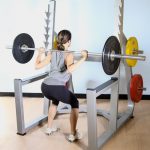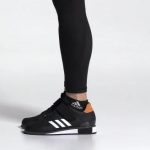Table of Contents
It’s no wonder that squat wedges are widely available; utilizing them has improved fitness in many ways. These squat wedges serve the same purpose, yet significant distinctions exist between them. The information provided in this evaluation of squat wedges will aid you in your search for the perfect pair.
List of Best Squat Wedges You Can Get
The Harderwill Squat Wedge Blocks are constructed of high-density silicone and are intended for more serious lifters.
Squatting shoes offer the advantage of not having any bounce or “give” while you descend with a big weight on the barbell. You want the same thing from your squat wedges: something robust that will not cause you to go farther while finishing your lift.
Harderwill sells these wedges in a four-pack that can be rigged for three different heights (1.3″, 2.2″, and 3.3″). The silicone is absolutely non-slip and odorless (unlike some of the nasty rubber gym equipment on the market, such as bumper plates).
The Harderwill Squat Wedge Blocks, which sell for roughly $60, tick all the boxes: dense, alternatives for varying degrees of lifting, and non-slip.
Iron Bull Strength and their equipment are two of my favorite brands. They are one of the only businesses I can always rely on to make great products, whether it’s a barbell pad for hip thrusts, weightlifting hooks, or bumper plates.
Iron Bull’s squat wedges are another high-quality option for dedicated lifters looking to improve their squat game. They are 5 inches wide and include up to two inches of heel elevation and a textured anti-slip surface for better foot positioning. These high-density rubber wedges, sold in pairs, will not compress or slide when lifted.
The only problem?
These items are often sold out. They are available for purchase (when in stock) on their website and on Amazon, but the last two times I looked, they were out of stock. Still, if you get the opportunity to purchase a pair of these wedges, take advantage of them. Your quads and squats will be grateful.
Squat wedges are often constructed of rubber, silicone, or high-density EVA foam. The XII: XI wedges attempt something different: a steel squat wedge or squat ramp. There are certain advantages to this kind of building, as well as some disadvantages.
To begin, the wedge is powder-coated to prevent rusting and corrosion, and the nine slots on the top of the wedge give more grip and traction when exercising. They stack easily for convenient storage between exercises. They can also support up to 800 pounds.
While these wedges are rather decent, they lack anti-slip treading to protect the wedges from sliding about. Smooth metal isn’t the best choice for a wedge finish. To assist minimize slippage, one reviewer put some tread/traction tape.
Squat wedges are sometimes sold in two sections, which allows you to tailor your foot angle and location. However, as compared to a one-piece squat wedge, they might seem less stable.

The TSTS Barbell Squat Block is an excellent example of a one-piece wedge that excels at the fundamentals.
The wedge is made of high-density rubber and is tilted at 20 degrees, with a lift of slightly under two inches at its maximum point. The wedge is surprisingly robust, weighing 14 pounds, making it great for big lifts and the assurance that your feet will not slip about as you work out.
The TSTS wedge is a touch pricy, costing more than $100 (see Amazon for current pricing and delivery choices), which may be out of most people’s budgets for something as tiny and basic as a wedge.
Are wedges good for squats?
Wedges can be used as an accessory to help with squats, but they are not essential. Wedges can be used to help with proper form and to assist in working certain muscles. However, wedges can also be dangerous if used incorrectly. It is best to consult a fitness professional before attempting any exercise with a wedge.
What angle is best for squat wedge?
The angle of the squat wedge should be determined based on the individual‘s body type and biomechanics. Generally, an angle between 15–30 degrees is recommended.
How do you pick a squat wedge?
When picking a squat wedge, you should consider a few factors, such as the material of the wedge, the size, the shape, and the type of foam padding. The material should be strong and durable enough to support your weight. The size should be appropriate for your body size and the type of squats you’ll be doing. The shape should provide adequate support and stability. Finally, the type of foam padding should be comfortable and supportive enough for your body.







